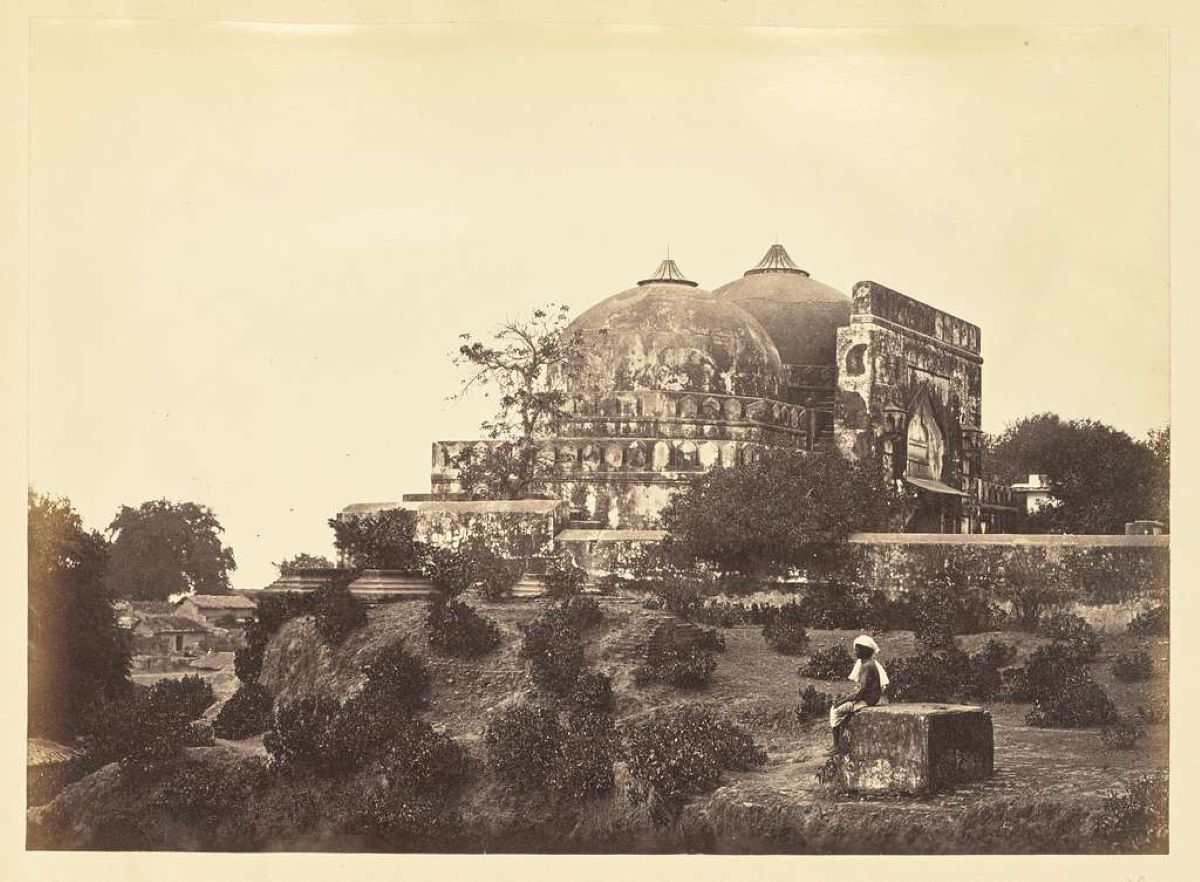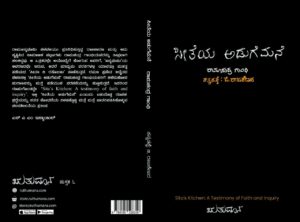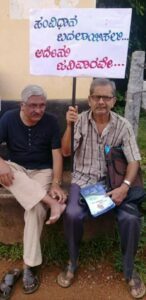G Rajashekar's translation of Ramachandra Gandhi's slim philosophical work on Ayodhya is being released online today. The concepts, which are complex for ordinary readers in Sita’s Kitchen, are communicated clearly.

A 19th century image of the Babri Masjid
Thirty years ago on this day (6 December 1992), the disputed mosque in Ayodhya — Babri Masjid — was razed to the ground with barbaric savagery reminiscent of the crude traditions of settling scores in medieval history. Today, Seetheya Aduge Mane by G Rajashekar, a Kannada translation of a work on Ayodhya — Sita’s Kitchen by Ramachandra Gandhi — is being released.
The heinous act of demolition of the Babri Masjid delivered a lethal blow to the image of a secular and democratic India. State machinery had a perch on a building next to the nearby Sita Rasoi Mandir, which served as a viewing gallery.
There has been no dearth of dissertations — journalistic and academic — since the Babri Masjid-Ram Janmabhoomi dispute flared up in 1986. This turned into a torrent after the demolition of the mosque on 6 December, but there was something out of the expected in November 1993. That was Sita’s Kitchen: A Testimony of Faith and Inquiry by Ramachandra Gandhi (Penguin India, 127 pages).
This slim volume by Mahatma Gandhi’s grandson Ramachandra Gandhi explores the myth as well as the reality of Ayodhya from a completely different perspective and in a startlingly new way.
Sita’s Kitchen is the name of a shrine situated within the compound of the Babri Masjid in Ayodhya. This book is a dialogical narrative with a prologue of contextualising meditations. It is a testimony of faith and inquiry — faith in the urgent relevance of India’s spiritual traditions to the future of life and civilisation on earth, and inquiry into the meaning of such central notions of these traditions such as aatman or self, shunyata or emptiness, ahimsa or non-violence.
Had Ramachandra Gandhi been alive, he would have had a heartbreak following the Supreme Court decision in 2019 to allow the construction, not of a grove of re-productivity in the heart of Ayodhya, but a temple to Lord Rama on the very site of the demolished mosque.
Nearly three decades after the violence at Ayodhya, as Prime Minister Narendra Modi gets ready to run for a third term, his ruling BJP is preparing to fulfil the promise of construction of the Ram Mandir. While the right-wing is arguing that the construction of the mosque nearly five centuries ago is a historical injustice that needed correction, moderates and secularists warn that building such a temple risks reigniting some of the deadliest sectarian violence in Indian history.
The translation of the slim valuable volume, Sita’s Kitchen, as Seetheya Aduge Mane by G Rajashekar is being released today. A lone, sane, intense, impressive, and combative voice against the majoritarian/Hindutva communalism in the seething cauldron of saffron hatred and violence of coastal Karnataka, Rajashekar, who took an immense risk, is unfortunately no more with us today.

Seetheya Aduge Mane by G Rajashekar, a Kannada translation of Ramachandra Gandhi’s Sita’s Kitchen (Supplied)
Ruthumana Publication is bringing out this volume. Nitesh Kuntyadi, who took the initiative to publish this volume, planned the release of the book on 6 December 2022.
Why 6 December? Besides being the 30th anniversary of the demolition of Babri Masjid, it is also the Mahaparinirvana Diwas (65th death anniversary) of Dr BR Ambedkar.
Ramachandra Gandhi, the author of Sita’s Kitchen, embodies both the spiritual tradition of India (for something of the spirit of his grandfather, Mahatma Gandhi, is powerfully present in his outlook) and the intellectual tradition of the West (for he holds an Oxford doctorate).
With this double focus, he explores philosophically, and in a way that shows the influence of Wittgenstein, what it is to be the conscious person in a community and shows how the religious ideas of the soul of God, prayer, immortality, the mystical, and miraculous are generated by a kind of necessity.
Ramachandra Gandhi was a student of Peter Strawson at Oxford, where he obtained a D.Phil. He taught philosophy at the University of Hyderabad, the University of Rajasthan, the University of Southampton, Viswa Bharati, and Delhi University. His books include Presuppositions of Human Communication, Two Essays on Whitehead’s Philosophic Approach, and Sita’s Kitchen.
The first part of this book explores the significance of the idea and reality of Sita’s Kitchen for the Ayodhya crisis and the spiritual life of India as a whole, not only for Hindus.
The second part of the book explores the Indian and universal significance of a Buddhist story, which records the Buddha’s advice to a group of aristocratic revellers in a forest to abandon their hunt for a prostitute, who has run off with their valuables and to seek instead their self.
Ramachandra Gandhi was troubled by the increasing tensions as extremist Hindus were threatening to demolish the mosque in 1990–91 and decided to go to Ayodhya himself. As he walked around the mosque, he noticed a sign which read, “Janmasthan Sita-ki-Rasoi”, which means ‘Birthplace Sita’s Kitchen’.
His exploration also leads him to a small shrine in a corner of the Babri Masjid, the compound known as Sita Ki Rasoi. Through interpretation of the Ramayana, Ramachandra Gandhi comes to the conclusion that this was a sacred grove commemorating the elemental power of the Earth Mother in aboriginal times, long before the great and ancient Hindu epics passed into the hands of “careerists and charlatans…chauvinists and courtiers of exploitative city-states”.
It was sacred to the Goddess, the great nurturing earth, the fecund source of all life, the aboriginal presupposition of all later religions. As an aboriginal place sacred to the Mother Goddess, the hill in Ayodhya brings together all religions. Rather than a source of conflict, Ayodhya should become a meeting ground for the divergent religious traditions of the world for their ultimate harmony.
This book starts with an exploration of something simple, and also deeply personal, as a dream. Upon closer scrutiny, its images seem inextricable, mixed up with memories of childhood and adolescence as such an expression of the subconscious is frequently wont to; yet deeper interpretation leads to other, more disturbing inquiries on hostility, materialism, the dualism of human life, and then eventually through a reading of sages and cornerstones of Indian spirituality, as advaita (non-duality) and ahimsa (non-violence).
Ramachandra Gandhi’s claim breaks free from fictionalising a Buddhist parable into an extended dialogue countering the forces of “nirvana and nihilism, ahimsa and absurdism, advaita and annihilationism”.
Though his narrative appears to be dull and turgid, cloaked in a heavy-duty philosophical jargon, it is the manner in which Ramachandra Gandhi tells his story — “subtly weaving bits of autobiography, myth, religious precept, political analysis, and imagined fable — which ensures that it gradually unfolds like a very well constructed movie or maybe a jataka tale”, said Sunil Sethi, in his review of Sita’s Kitchen published in India Today in February 1993.
It can undoubtedly be haunting, heartbreaking and also healing to read this book, which is almost like a new upanishad, a prayer for an end to violence.
To translate a treatise of this kind into Kannada is not an easy task. Besides scholarship, the translator should have mastery over both languages.
Rajashekar had all the prerequisite qualifications to translate Sita’s Kitchen.
He was a very important cultural and political critic of our times, yet always stayed away from the limelight. But his relentless, reflective writings ranging from literature, culture, and politics to communalism have immensely contributed to the cultural and political discourse shaping our times.
One of the most committed public intellectuals, he fought for decades against the scourge of communalisation across the country. He can only be likened to socialist writer Raymond Henry Williams.

Public intellectual G Rajashekar (right) with writer and activist K Phaniraj at a protest (Supplied)
According to writer and senior journalist NAM Ismail, who has written the preface of Seetheya Aduge Mane, Rajashekar felt the need to translate Sita’s Kitchen after the Supreme Court verdict on the Babri Masjid case in November 2019.
At the time of translating this work, he was struggling with his diminishing memory power. He was ill, but for him, the translation was a question of life and death.
“Before commencing his own translation, where he stopped the previous day, he used to read the previous three pages of his own translation, to gain a hold on the subject again and keeping continuity in mind,” recounts Nitesh Kuntyadi, publisher of this volume.
Because of the determination of Rajashekar, who never compromised with his mission impossible to translate this work, Seetheya Aduge Mane is ready for release.
Efforts invested by Rajashekar and his conviction about the issues are visible in the translation. The concepts of Ramachandra Gandhi, which are complex for ordinary readers in Sita’s Kitchen, are communicated clearly.
It is worthy that the last contribution of Rajashekar was for the values he believed in throughout his life. Interestingly, the translator’s friends have decided to design the cover in black colour, “as a mark of protest”, explains Nitesh. A worthy, meaningful tribute to him.
The book has now been released online. It is under pre-order and available here.
(Corrigendum: The publisher of Rutumana hereby clarifies that “the original plan was not to release the book at the Dalit Convention in Bengaluru on 6 December”. The publisher wanted to release the work online on 6 December on the anniversary of the demolition of the Babri Masjid. As planned, ‘Seetheya Aduge Mane’ was released online. The release of this volume has nothing to do with the Dalit Convention. The writer Muralidhara Khajane profusely regrets his misunderstanding and this error)
(Muralidhara Khajane is a senior journalist, writer, and film critic. He is the author of ‘Random Reflections: A Kaleidoscopic Musings on Kannada Cinema’. These are the personal views of the author)

Feb 18, 2024

Aug 09, 2023

Aug 07, 2023

Apr 30, 2023

Mar 23, 2023

Mar 23, 2023